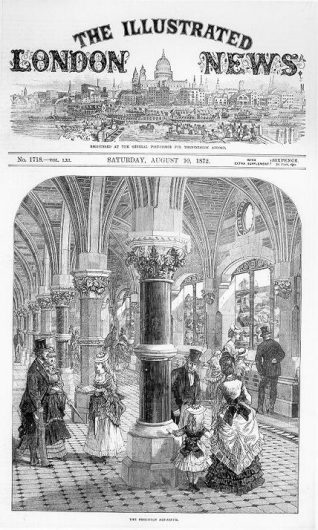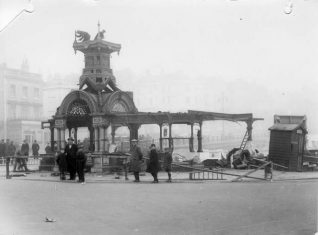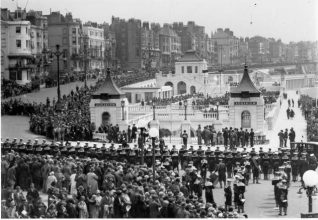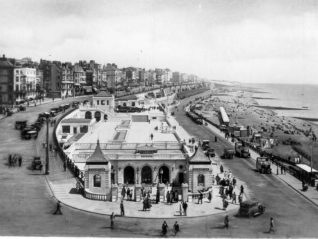History of the aquarium and dolphinarium, 1872 - 1987





Note that this text is an extract from a reference work written in 1990. Some of the information may therefore be out of date.
{24,123,256}
a) ORIGIN: Brighton Aquarium was the brainchild of Eugenius Birch, the famous pier engineer and designer of Brighton’s West Pier, who conceived the idea following a visit to Boulogne Aquarium. Erected on the approach roadway to the Chain Pier, the Aquarium necessitated the construction of a new sea-wall and promenade, the Madeira Road, which was commenced in 1869. The whole project was completed in 1872 at a cost of £130,000, and the Aquarium was inaugurated by Prince Arthur at Easter although there were no exhibits at the time. It was formally opened to the public on 10 August 1872 by the mayor, Cordy Burrows.
b) DESCRIPTION: The new Italianate building extended for about 700 feet along the base of the cliff. The entrance was at the western end, on the site of the Chain Pier’s toll-house, where a wide flight of steps descended into a large courtyard formed by five red-brick arches and terracotta columns. Inside the building a large entrance hall led into the main aquarium corridor, 224 feet long and lined with large tanks lit from behind to add to the air of mystery. This impressive corridor, with its vaulted ceiling supported by columns of granite and marble decorated with marine capitals, remains the main aquarium hall and is now listed as being of special architectural and historic interest. The visitor then entered a central hall, now the Dolphin Lounge, which housed a hundred-foot tank to Birch’s unique design; holding 110,000 gallons, it was the largest display tank in the world at that time. Marine exhibits were not the only attraction however, as a reading room, restaurant and a conservatory with fernery, rockery and cascade were also provided.
The roof terrace was completed in the summer of 1874 and a distinctive clock tower, gateway and toll-houses were added by T.Boxall in the October of that year. In June 1876 the terrace was extended by 180 feet and a roller-skating rink, terrace garden, smoking room, caf..e/. and music conservatory were all added on the roof.
c) NINETEENTH-CENTURY DEVELOPMENTS: The Aquarium proved to be an instant success with the town’s fashionable society and received many royal visitors. Among the early attractions was a large octopus, and in 1877 the first sea-lions arrived; the exhibition of a live Norway lobster in 1874 caused a furore! By 1880 organ recitals were being given twice daily in the hall, while concerts under the direction of William Kuhe were performed in the conservatory. In 1883 lectures and exhibitions were introduced to further stimulate public interest, and in 1889 a dramatic licence for the production of plays was obtained.
d) CORPORATION PURCHASE: The initial success was not sustained however, and by the turn of the century the Aquarium was in financial difficulty. In October 1901 the building and business were purchased by the corporation for just £30,000, and Brighton Aquarium was henceforth managed as a municipal enterprise, apart from a brief private letting in 1905 and 1906. The Aquarium’s popularity then rose again as Brighton’s fortunes in general revived. From 1907 until 1918 a municipal orchestra played in the conservatory which was renamed the Winter Garden. There were also occasional film shows from before 1900, and in the First World War the Winter Garden was briefly known as the Aquarium Kinema; film shows continued until 1939. {68,68a}
In July 1922 Brighton Council gave the Southdown bus company permission to convert the building into a bus and coach station, but the plan was unexpectedly withdrawn at a public inquiry.
e) RECONSTRUCTION and POST-WAR DEVELOPMENTS: In 1927 the Aquarium closed for a £117,000 modernisation to the plans of borough engineer David Edwards. When it was reopened by the Duke of York on 12 June 1929, the exterior had been rebuilt in white Empire stonework, the entrance was replaced by two square kiosks with pagoda-style roofs, and the distinctive clock tower had been demolished. A new entrance hall had been built with an adjoining restaurant, while the Winter Garden had been transformed into the Prince’s Hall, a modern concert hall seating some 1,250 people. A ballroom, bandstand and other small buildings were added to the Sun Terrace which was extended eastwards above a colonnade and shops to meet the Madeira Terrace. A lift was also installed from Marine Parade down into the Aquarium, while the subway to the Lower Esplanade was opened in 1935. Both slipper and shower baths, which closed in about 1979, and a miniature rifle-range were also provided.
During the war the Aquarium was requisitioned by the RAF. When it reopened, chimpanzee tea-parties and other small animal attractions were introduced, but in 1955 the building was privately leased again, to Aquarium Entertainments Ltd. The Prince’s Hall, which had been used nightly as a ballroom, later became the Florida Rooms night-club but was transformed in 1961 into the Montagu Motor Museum.
The first pair of dolphins were exhibited in a pool at the western end of the Aquarium in 1968 and proved so popular that the motor museum was converted into a permanent dolphin attraction. Opening at Easter 1969, the dolphinarium has seating for a thousand visitors around an oval pool holding 210,000 gallons of sea-water. However, serious concern about the effect of permanent enclosure on these intelligent mammals has led to a considerable movement to close the dolphinarium and, to a lesser extent, the whole aquarium.
Pirates Deep, an indoor adventure playcentre for children, has opened in another part of the building while the most recent addition is the shark pool of April 1987. The Sun Terrace has been converted into a popular small-scale funfair and amusement centre, Holiday World.
Any numerical cross-references in the text above refer to resources in the Sources and Bibliography section of the Encyclopaedia of Brighton by Tim Carder.




Comments about this page
Hopefully the dolphins are no longer part of the entertainment? I remember there were many demonstrations outside the aquarium in an attempt to stop the exploitation of these animals who should be in the sea and not underground.
No they were “tagged” and released into the wild where their lives were almost immediately cut short (at least in comparison to their captive life expectancy) by causes unknown (possible causes of death were disease, shark attack or most likely attack by fellow dolphin).
I heard that this aquarium was originally built to be a freak show. Can anyone let me know how or why this rumour may have started since it is obvious that it wasn’t after reading this article.
Hello everyone, we’re trying to gather as much information about the aquarium whilst it held marine mammals for our non-profit website about the history of defunct marine mammal parks all over the world. Our website: http://www.freewebs.com/defunctmarinemammalparks/
It looks as if the original seating and pool from the dolphins is still in place in the pool where there is a glass walkway. Can anyone confirm whether this is the original dolphin pool/seating? To Joanna, about the freakyshow, that could just be a rumour, but in the nature of Brighton, anything is possible!
Jo, you may have come across a rumour confusing the Aquarium with the Booth Museum of Natural History (Hove) which was originally built in 1807 for stuffed British birds, but over the years acquired weird and wonderful artifacts. Some such objects included deformed animal foetuses and grotesque texidermy pieces depicting the anthropomorphism of common animals. Does this help?
A friend of mine worked at the Sea Life Centre during the 90s and has said large parts of the centre (the ballroom for example) are still not open to the public due to the fact its too costly to remove the asbestos.
Joanna, in 1886 ‘a real live mermaid-half beautiful woman , half fish’ was exhibited at the Brighton Aquarium-( I have a copy of an old poster for the exhibition). Maybe this is why the Aquarium had a reputation for being a ‘freak show’?
I think the date 1955 for the ballroom years is wrong as my father was the ballroom manager there in the late 1940’s.
A very interesting article. Thank you.
I have a “souvenir of Brighton” quill pen. It was passed down to me from my grandparents. It looks like ivory, it unscrews into two pieces, one half is a steel quill pen, the other half has a small crystal imbedded in the top that you can look through that has 6 images. West Pier, Chain Pier, the aquarium, King’s Road, the Pavillion and the electric railway. Does anybody have a clue as to when this may have been sold or any other information about this item?
Defunct Marine Mammal Parks: I used to watch the dolphins in the early 80s at Brighton and revisted recently. The turtle and shark pool is the same one as the Dolphinarium. It’s the same size, location and seating layout but they have sealed off the stage to the back and removed some seating to the back of the room. Marty: The 1980s dolphinarium and current shark tank IS the old ballroom, so it seems your friend is (at least partially) wrong there!
My father managed the Aquarium when it was the Florida Night Club, his name was George Herbert Wilson. We lost contact with his family when he died in 1960, I am seeking any relations of his.
No one has mentioned the Chinese Jazz club that was there on a Friday night – all night. They had a drinks licence too. It was definitely in operation at the end of the 50s and the beginning of the 60s. Some great acts played live there too including Temperance Seven and, I believe, Rod Stewart.
I worked as a marine mammal trainer from 1987 to 1990.
Editor’s note: Maybe you could share your memories of that time with us Martin? Contact me: jennifer@mybrightonandhov.org.uk
My nanna used to live in Brighton. I can remember seeing the dolphins when I was 4 or 5. Which would be 1968/9.
Regarding the Brighton pen with the Chain Pier – this can be dated to around or before the Chain Pier’s destruction in the 19th century. It won’t have been made after (I don’t think) but, of course, like an old postcard, may still have been sold as a souvenir after the loss of this landmark.
As an ex-dolphin trainer (the 1st at Brighton in fact), I can confirm that the seating in the old dolphin pool is the original and that the original pool was filled in and the entrance/souvenir room is now occupying that site.
The clock maker was Thomas Boxell, not Boxall. Yes, I am related! Google: Thomas Boxell was born in Brighton in 1823, the son of Ann and John Boxell, an ostler of Rock Street, Brighton. Thomas Boxell, who was baptised “Thomas Boxall” at Brighton’s St Nicholas’ Church on 28th December 1823, generally spelt his surname as “Boxell” but his family name is often recorded as ‘Boxall’ in census returns and trade directories. Thomas Boxell had three younger brothers –Joseph Boxell (born 1830, Brighton), Frederick Boxell (born c1832, Brighton) and Nathan Boxell (born c1835, Brighton).
Hi Geoff,
The original clock face displayed the maker’s name quite clearly as T. Boxell. However, as you have observed, in an age when so many people were illiterate, names were often recorded phonetically resulting in the records showing what the person who recorded it thought they heard.
Regards, Andy
There was an underground shooting range at the far western end of the Aquarium licenced for .22 rifle and ‘full bore’ pistols . I shot pistol there for several years in the 70s of 9mm and .357 magnum . Others used up to .44 magnum calibre. My club was the Brighton and Hove Rifle and Pistol club. Of course everything changed after Dunblain. The butts backed on to the public toilets which were under the arches. In fact the gents’ urinals were the other side of the butts protective steel plate which must’ve caused many a ‘relieving’ gentleman to wonder what the thumping noise was on the other side of the porcelain. If only they’d known they were in fact facing a fusillade of very powerful gunfire.
My father told me that Thomas Boxell made the clock at the beginning of the pier.
My brother’s name was Clive Boxell but he’s deceased about five years ago. He and my father often discussed Boxell clocks (my father’s name was Frederick) and I believe my brother owned one at some time during his life.
My grandfather Lionel “Frank” Beal ( Beal family were Brighton residents from the mid 19th C ) had a small electrical shop in the North Laine’s and had several contracts with the Brighton Corporation also did some electrical? work at the dolphinarium in the late 1960’s. I remember being taken there whilst there were no performances to see the dolphins and my grandfather who was working on a job there. I seem to remember that the pool was very small, I am so pleased that it no longer exists.
Add a comment about this page